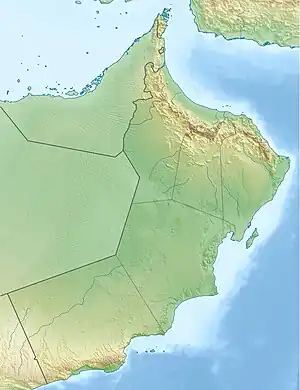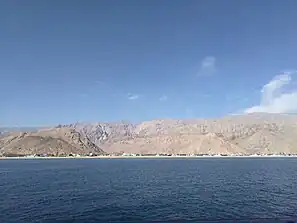Dibba Al-Baya
Dibbā Al-Bayʿah (Arabic: دِبَّا ٱلْبَيْعَة)[2][3] is geographically part of the Dibba region that faces the Arabian Sea, and is bordered by the United Arab Emirates to the south. It is a Wilayat in the Muhafazah of Musandam, Sultanate of Oman, on the east coast of the Arabian Peninsula.It is considered one of the most famous Omani cities known in the pre-Islamic days because it contains Dibba market, which is one of the most famous Arab markets that was known at that time, as merchants from different countries around the world such as India, Sindh and China used to come to it, and some historians, such as Al-Asmai, attribute this name to the locusts Creeping to express the large number of people in it, and the area of that city is approximately 37 km2.[4]
Dibba Al-Bay'ah
دِبَّا ٱلْبَيْعَة | |
|---|---|
 Dibba Al-Bay'ah Location in Oman | |
| Coordinates: 25.64°N 56.266667°E | |
| Country | |
| Governorate | Musandam |
| Wilayat | Dibba Al-Bay'ah |
| Area | |
| • Land | 491 km2 (190 sq mi) |
| Population (2018-07-01)[1] | |
| • Total | 9,873 |
| estimate | |
Available Services and Trades
In Dibba, three schools for boys and girls have been created in the sphere of education, and these schools can accommodate roughly 1041 male and female students. There are also many services and development projects available. There are now several specialized treatment facilities in the field of health, and there is a modern road network that connects the state's villages, like the Dibba-Khasab mountain road, as well as a number of projects that have been launched recently, like the groundwater dam and water desalination projects. the art of grazing, raising cattle, and farming, including the production of citrus, dates, and fruits.There are also traditional industries such as the textile industry, the manufacture of small ships, boats, palm trees, and blacksmithing.[4]
Well-Known Folk Customs and Traditions
The inherited customs still practiced in Dibba can be broken down into two categories:
Non-material customs
Such as marriage, folk games, arts, hospitality, Newroz celebrations, blood donation, travel, carrying weapons, and religious practices.
Material folk customs
Such as women's industries, leather and arms manufacturing, agriculture, carpentry, clothing, house construction, and animal husbandry.[4]
Climate
The air temperature lowers to +34...+37°C in the evening, with a dew point of +23,49°C; Extremely uncomfortable, somewhat oppressive ratio of temperature, wind speed, and humidity; little chance of precipitation, gentle breeze There is a 4 to 7 km/h south-west breeze blowing, and there are occasionally a few small clouds in the sky.[5]
Natural Attractions

As it has plains and blue waters rich in coral reefs, dolphins, and other marine life, the city of Dibba is known for its diversity of varied terrains. There are also mountains and sizable bays, such Khor Al-Mim, Khor Zghi, and Khor Khafah, which makes the city attractive to tourists, who frequent it in huge numbers. Due to its alluring beauty and tranquility, it is also well-known for having sand dunes named Al-Sahma Al-Bayda in the Al-South region, as well as valleys like Wadi Al-Khab and Wadi Al-Yadi, as well as the presence of springs that can produce running water, including the spring of Al-Saqqa water.[4]
See also
References
- "Oman: Administrative Division (Governorates and Districts) - Population Statistics, Charts and Map".
- Lancaster, Fidelity; Lancaster, William (2011). Honour is in Contentment: Life Before Oil in Ras Al-Khaimah (UAE) and Some Neighbouring Regions. Berlin, New York: Walter de Gruyter. pp. 248–497. ISBN 978-3-1102-2339-2.
- Morton, Michael Quentin (15 April 2016). Keepers of the Golden Shore: A History of the United Arab Emirates (1st ed.). London: Reaktion Books. ISBN 978-1-7802-3580-6. Retrieved 8 November 2016.
- "تعرف على ولاية دبا عُمان من كل جوانبها". Retrieved 2023-08-11.
- "Weather in Dibba Al-Baya - accurate and detailed weather forecast in Dibba Al-Baya for today, tomorrow and week. Dibba Al-Baya, Musandam, Oman". meteotrend.com. Retrieved 2023-08-11.